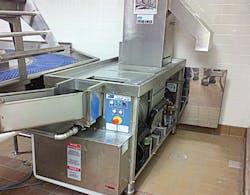Have you ever thought about how much food disposal costs your property each year?
Dining centers and cafeterias can be notorious sources of leftovers. The kitchen staff may be eating the cost of excess food, but your facilities department is footing the bill for water, energy, and garbage.
Keep your budget from getting burnt by installing a food pulper. These heavy-duty machines divert organic waste for composting and leave your trash bins a little lighter in the process.
A Bushel of Benefits
Food is the largest waste stream received by landfills – some 35 million tons each year, according to the EPA. Only a scant 5% of organic materials is diverted for resuse. The rest occupies valuable landfill space and releases methane gas as it decomposes.
Food pulpers not only ease the burden on landfills and sewage treatment plants, but they also reduce water and disposal costs for building managers.
"A pulper makes food waste collection more efficient and manageable, particularly for places like schools and hospital cafeterias that serve a high volume of customers in a short period of time," says Liz Christiansen, director of sustainability at the University of Iowa.
Scraps are ground into small particles and the resulting pulp is directed through a chute for collection. Like a cardboard baler, the machine reduces the total volume of waste material.
Food Pulper Earns College Credit
The University of Iowa has several pulpers churning away leftovers from Hawkeye students and patients in its research hospitals.
The UI Hillcrest Marketplace, a dining center, serves an average of 24,000 meals a week. Composting was already in place for kitchen preparation scraps and leftovers, but the university wanted to capture an even larger portion of waste.
The $45,000 pulper was completely funded by an internal research grant and one from the state Department of Natural Resources. The machine saves $25,000 a year in water costs alone, yielding a simple payback of less than two years.
The Hillcrest pulper has also reduced waste by 66% from 2012 – slashing food waste to 2,800 pounds per week from 8,533. The resulting pulp is processed by the city landfill's composting program.
"Even after our increased hauling expense of the food waste, we had a yearly net savings of $11,000," says Fred Kurt, a Hillcrest operations manager.
The pulper also dewaters food, which leaves the leftover material far lighter than when wet. The greywater is then recycled within the machine, which uses as little as two gallons a minute.
That's a significant savings over garbage disposals, which can consume 10-15 gallons of fresh water per minute, explains Fred Kurt, an operations manager for the University of Iowa. Given that either machine would run from open until close in a large dining facility, you could conserve thousands of gallons on a daily basis by switching to a pulper.
The ideal fate of the pulp is a composting program. Make sure the pulp is free of inorganic materials. Unless they are biodegradable, items like plastics, Styrofoam, foil, cardboard, and other packaging debris will contaminate the mixture.
If you don't have a way of separating these items or composting options aren't available, you can still benefit from a pulper. Just one machine can decrease food waste by as much as 80% and reduce potable water use by up to 40%, notes the EPA.
A Feast of Considerations
When evaluating pulper models, make sure your selection can handle the volume of leftovers your facility produces, says Kurt. Conduct a waste audit, which will also provide the necessary data to calculate ROI.
Because of the machine's size and piping requirements, a dishroom renovation is an ideal time to upgrade to a pulper. A pulper can be retrofitted into an existing system, notes Kurt, though stainless steel fabrication will be necessary.
Preventive maintenance is key with these industrial machines. "The pulper needs a thorough cleaning at the end of each day," Kurt explains. "The blades should also be changed out on a yearly basis."
Installing a food pulper can be a gateway to other waste management and water conservation practices. These machines go hand-in-hand with energy-efficient dishwashing machines, trayless dining rooms, and biodegradable packaging.
You can also collaborate with the kitchen staff on the efficiency of menu planning, such as reducing portion sizes and reusing pre-consumer leftovers in other dishes.
"In the long term, it is important to develop a waste-free society," says Kurt. "Switching to a food pulper is the right thing to do."
Jennie Morton is senior editor of BUILDINGS.
About the Author
Jennie Morton
A former BUILDINGS editor, Jennie Morton is a freelance writer specializing in commercial architecture, IoT and proptech.
